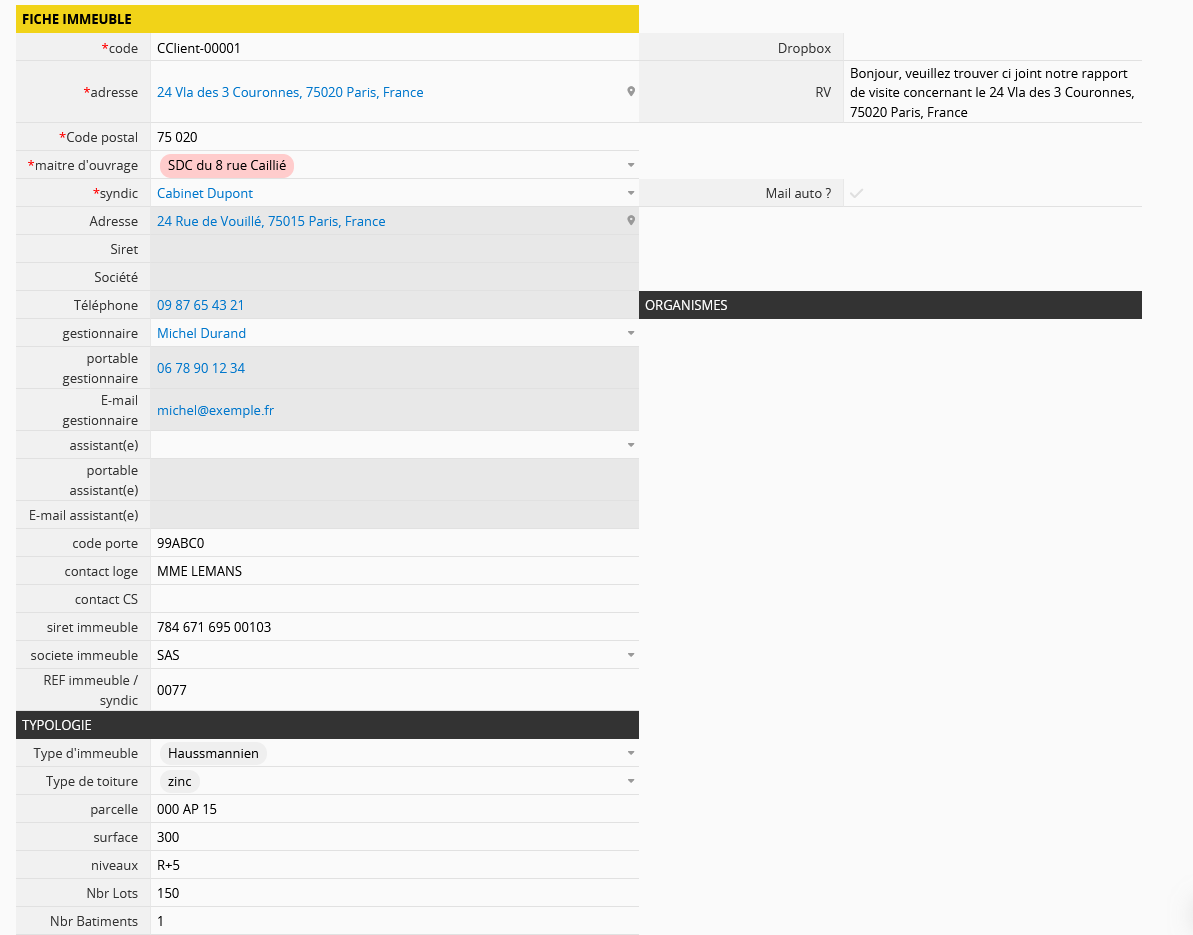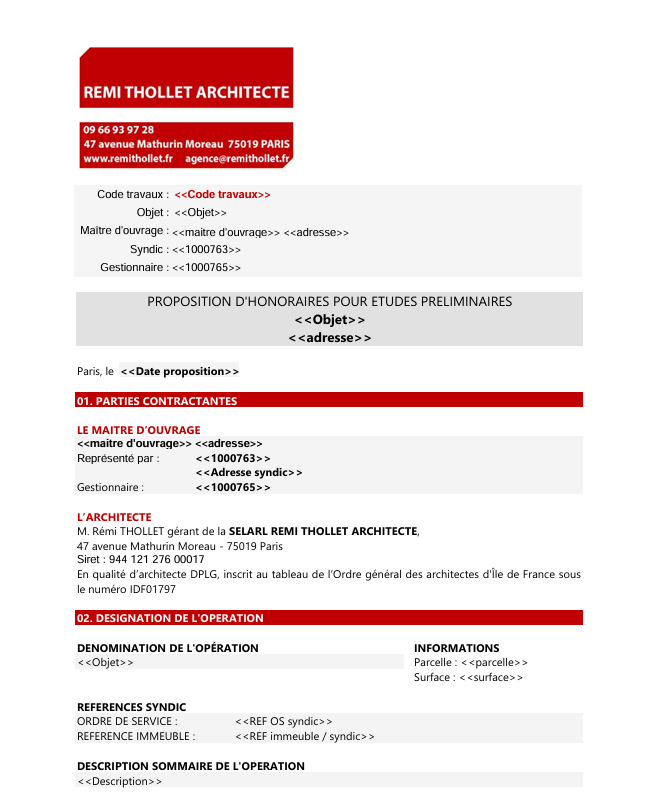Rehabilitating Old Buildings Through Digital Tools: The Agency That Adopted Ragic
.png)
| Company name | Agence d'architecture Rémi Thollet & Thomas Kochanski |
| Industry | Architecture |
| Benefits of Implementation | |
| Applications | Building management database, accounting management, creation of official documents directly from Ragic |
| Subscription | Professional Plan |
| Scale of Use | 9 Internal users |
- Thomas Kochanski, co-founder, Architecture Agency Remi Thollet & Thomas Kochanski
Architects of Rehabilitation: Where Technical Expertise Meets Social Responsibility
For nearly 15 years, Thomas Kochanski and his team, now working together within the l’agence d’architecture Rémi Thollet & Thomas Kochanski, have devoted their expertise to the renovation and rehabilitation of old buildings, an activity that Thomas himself describes as both niche and highly specialized.
Their practice is structured around two main focuses. The first, thermal improvement, has naturally developed in the wake of recent public policies. The second and perhaps the most representative of their identity, is the rehabilitation of deteriorated housing. This field also benefits from government support, aimed at helping property owners preserve inhabited heritage buildings.
This is where the agency truly stands out. While traditional architecture firms typically handle only a few projects per year from design to construction, Thomas and his partners often intervene multiple times on the same building; whether it's to repair water damage, redo flooring, or restore the facade, these are all part of the ongoing maintenance of an old structure.

Each project also involves a human dimension: Temporarily relocating residents, monitoring construction progress, and ensuring that everyone can return to their homes as quickly as possible. Over time, the agency has developed a dual expertise, both technical and social, that goes beyond construction in the traditional sense to become a true preservation effort. The goal is not to erect new buildings, but to safeguard old ones (mostly Haussmann-style or early 20th-century) that are still inhabited, while respecting the lives of those who live there.
Their work focuses on Paris and its inner suburbs. Although the agency sometimes deals with concrete structures, it does not target the large housing blocks typical of Greater Paris, which require a different kind of technical and social expertise. This mode of operation, involving multiple successive interventions on the same building, inevitably leads to a proliferation of documents. Managing this growing flow of data soon became a challenge in its own right.
When Shared Files Fall Short
At the beginning, the agency made do with the resources it had. As Thomas recalls, "We did what we could. We had a host server with a few files and some databases, it was FTP. So they were Excel files, when one person made an update, the other had to synchronize [their data]." Later on, the arrival of Dropbox marked an improvement in coordination among team members, but it was far from perfect. Manual updates were sometimes left unreported, and a colleague could accidentally overwrite new data, leading to confusion, wasted time, and loss of efficiency.
This way of working was still manageable when the team had only two or three members and the database referenced fewer than 300 buildings. But by the end of 2019, business growth had made the situation unsustainable. Finding information had become time-consuming to the point of slowing down daily operations. Even simple tasks like editing the header of an official document, could turn into a real headache due to the number of interventions and the diversity of stakeholders involved. Manual copy-pasting became increasingly frequent, sometimes from outdated documents, creating version discrepancies and raising the risk of errors. The need for a proper database had become undeniable.

Screenshot of the agency’s Building sheet in its database, using sample data.
Ragic, the Perfect Balance Between Cost, Tools, and Flexibility
The Covid-19 pandemic in 2020 temporarily brought the agency’s operations to a halt, giving Thomas time to rethink how their data was organized. His first instinct was to try Airtable. However, the lack of native integration with Excel and Word quickly became a deal-breaker: the agency absolutely needed to generate Microsoft Office documents directly from its database.
He then turned to independent developers but quickly encountered two major obstacles. First, the cost: It would have taken between €10,000 and €15,000 just for the creation of a custom database and its interface. Second is the rigidity of such a system. "I immediately noticed how limited the system was when it came to making changes. Today, our setup doesn’t evolve much because we’ve built something that works, but back then, I knew we’d need to make updates almost every week. And those updates, of course, came at a cost, which is fair enough but it just didn’t suit us. We wouldn’t have been able to manage things the way we wanted."
It was almost by chance that Thomas discovered Ragic at a time when the platform wasn’t even available in French (now available). The revelation was immediate: The platform met his needs, ticking all the boxes while eliminating unnecessary complications.
Today, they no longer juggle among multiple tools: Ragic natively supports Excel import, Word mail-merge, and export to Excel, Word, or PDF. For an agency that regularly produces official documents in standard formats, this is a huge life saver.
Additionally, the Ragic's pricing model appealed to Thomas. After the free trial, users can either stay on a limited free plan or subscribe to a paid one, billed according to the number of internal users. The agency has since chosen the Professional plan, which gives access to all Ragic features. With 9 internal users, their annual costs amounts to approximately USD 1,900, which, in Thomas’s words, is “very reasonable considering the service provided.”
Finally, another key advantage of Ragic compared to a traditional custom-built solution is the software’s fully customizable nature. Every modification, addition, or field deletion can be done instantly by the user, without the need for extra costs, coding, or third-party help. “What’s great about Ragic is that it’s immediate. We try things. If they work, perfect. If not, we do it differently,” Thomas sums up.
Ragic in Everyday Use
Over time, Ragic has become an integral part of the agency’s daily operations. As Thomas emphasizes, Ragic is “even more than indispensable. It’s our central work hub, everything goes through it. I use it fifty times a day because I get fifty questions a day. So before answering, I open the record with the right information, check where we stand… it’s truly indispensable.”
The agency’s database is organized with around 5 tabs: Two are dedicated to accounting operations, 1 contains various reports, and another entitled "Base de données" houses all the information necessary for daily operations. While their old file-sharing system had recorded up to 300 buildings before it became a bottleneck, the Buildings sheet in the Database tab now lists 1,942 buildings without issue. Similarly, 280 homeowners’ associations are gathered in their dedicated sheet, while the sheets for property managers and partner companies contain 439 and 412 entries respectively.
Ragic automates routine tasks, reinforcing team autonomy and saving valuable time on a daily basis. To illustrate, the workflow for issuing a fee proposal is as follows:
- Entering information into various sheets ("Companies", "Homeowners’ Associations", "Acte d’engagement"), each organized across multiple tabs.
- Automatic linking of fields on the "Operations" sheet using Ragic linking tools (Link and Load, Show References from Existing Sheets and Link Fields from Parent Sheets).
- Importing a Word mail merge template, including agency logos and a fully customized layout.
- Once the template is imported and data updated, a single click generates a Word report with the correct formatting.

Word mail merge template used for generating fee proposals.
A similar mechanism is used for accounting management, allowing Thomas and his colleagues to instantly check for calculation errors.
In addition, still related to accounting operations, the agency regularly uses Ragic’s report generation feature. This is used not only to produce annual statements but also other essential documents, such as monthly VAT declarations. The process is simple: select the source sheets (here, the company’s bank accounts and operations), define the type of report and the fields to display, and it’s done.
Thanks to Ragic, the agency has not only streamlined its internal management but has also gained peace of mind, allowing more time to focus on what matters most: rehabilitating buildings and supporting residents.
The Future of the Agency? Full-Scale Renovation Projects, Still Powered by Ragic!
The agency’s activity is rapidly growing, and Thomas and his colleagues are approaching the future with confidence. After carrying out multiple successive interventions on the same building, they are now turning to full-scale building rehabilitations, an ambitious approach that complements their existing expertise.
As Thomas points out, they are “dependent” on the software, which has become a central tool in their daily work, and he adds with a smile, “It would be more than inconvenient if Ragic had to shut down.” No need to worry! Ragic is also expanding rapidly, with new languages, new modules (including an in-house AI to guide users through the platform), and increasingly advanced features to support user growth.
Since 2010, architects Rémi Thollet and Thomas Kochanski have dedicated themselves to auditing and rehabilitating buildings in Paris. In the early days of their practice, they organized their data using Excel spreadsheets and Google Docs, but this system quickly showed its limits as their activities grew. Today, their agency has made Ragic its go-to tool. From organizing site visits to preparing fee proposals, everything now runs through the platform.
Category: Case Studies > Constructions



